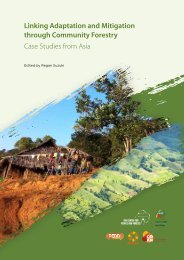Desktop Study on - Regional Climate Change Adaptation ...
Desktop Study on - Regional Climate Change Adaptation ...
Desktop Study on - Regional Climate Change Adaptation ...
Create successful ePaper yourself
Turn your PDF publications into a flip-book with our unique Google optimized e-Paper software.
Assessment of Capacity Gaps and Needs of South East Asia Countries<br />
in Addressing Impacts, Vulnerability and Adaptati<strong>on</strong> to <strong>Climate</strong> Variability and <strong>Climate</strong> <strong>Change</strong><br />
the Center for Agriculture and Forestry Research<br />
Informati<strong>on</strong> 2009 - 2013, published in December<br />
2008, and limits to bio-fuels as energy resources and<br />
carb<strong>on</strong> sequestrati<strong>on</strong> in the strategic plan for 2007 -<br />
2012 (NAFRI, 2008a). In the NAPA, it is stated that no<br />
adequate tools and equipments are available to the<br />
NAFRI for developing and promoting animal species<br />
and crop varieties that are adapted to the local<br />
natural hazard c<strong>on</strong>diti<strong>on</strong>s (Lao PDR, 2009a). This gap<br />
is intended to be tackled by NAPA’s project number<br />
6. Another example is project number 13, that<br />
addresses the lack of capacity of technical staff for<br />
researching <strong>on</strong> and developing biological fertilizers<br />
in order to improve the agricultural producti<strong>on</strong> (Lao<br />
PDR, 2009a).<br />
Lao PDR being majorly a rice crop based ec<strong>on</strong>omy,<br />
there is a need for both direct and indirect<br />
assessment of climate change impacts <strong>on</strong> rice value<br />
chain. However, this appears to be off the radar at<br />
this point of time in the government or various d<strong>on</strong>or<br />
agencies being in the strategy and planning process.<br />
Moreover, in order to assess the direct biological<br />
impacts of climate change, an applicati<strong>on</strong> of crop<br />
growth model is needed. Lao PDR is yet to exercise<br />
such models or risk management approaches in this<br />
c<strong>on</strong>text. Furthermore, in order to understand the<br />
potential impacts of water shortage, groundwater<br />
depleti<strong>on</strong> and its implicati<strong>on</strong> to livelihood or income<br />
generati<strong>on</strong>, a basic modelling toolkit such as water<br />
balance model, input-output optimizati<strong>on</strong> and<br />
maximizati<strong>on</strong> methods and practices are important<br />
that is unavailable for informed decisi<strong>on</strong> making<br />
processes.<br />
Recent Projects in the Agriculture<br />
Sector<br />
In August 2009, the GEF submitted a project proposal<br />
from the UNDP to the Least Developed Countries<br />
Fund (LDCF), intended to improve the resilience<br />
of the Lao agricultural sector to climate change<br />
impacts (GEF, 2009). The project aims to fulfil the<br />
implementati<strong>on</strong> by 2014, including the comp<strong>on</strong>ents<br />
of access to climate risk informati<strong>on</strong>, policy analysis<br />
and capacity building, community-based climate risk<br />
reducti<strong>on</strong>, and adaptati<strong>on</strong> learning.<br />
Socio-Ec<strong>on</strong>omic Sector<br />
Range of Studies Reviewed and<br />
Methods Applied<br />
Data and informati<strong>on</strong> <strong>on</strong> socio-ec<strong>on</strong>omic implicati<strong>on</strong>s<br />
of disasters has been reviewed from the Internati<strong>on</strong>al<br />
Disaster Database (EM-DAT, 2009) and the Global<br />
Facility for Disaster Risk and Recovery (GFDRR,<br />
2009a).<br />
The Lao PDR NAPA report (Lao PDR, 2009a) and<br />
food security and vulnerability analysis of the<br />
WFP (2007) provides informati<strong>on</strong> <strong>on</strong> Lao PDR’s<br />
vulnerability regarding socio-ec<strong>on</strong>omic aspects.<br />
Regarding adaptati<strong>on</strong> strategies, Brahmi and<br />
Poumph<strong>on</strong>e (2002) c<strong>on</strong>ducted a study <strong>on</strong> local<br />
coping mechanisms in disaster management through<br />
a survey in nine Lao villages of different geographical<br />
and ethnical ranges.<br />
Socio-Ec<strong>on</strong>omic Impacts<br />
The most recent major natural hazard – number nine<br />
out of the top ten regarding the number of affected<br />
people in the period 1980-2009 – was a flood in<br />
August 2008 (EM-DAT, 2009). It is estimated to have<br />
affected more than 204,000 people, damaged 50,000<br />
ha of arable land and caused an ec<strong>on</strong>omic loss of over<br />
US$ 9 milli<strong>on</strong> (EM-DAT, 2009; GFDRR, 2009d). The<br />
GFDRR notes that because of high degree of poverty<br />
in rural areas, even natural disasters of low intensity<br />
affect rural farmers (GFDRR, 2009a).<br />
A key issue regarding socio-ec<strong>on</strong>omic impacts is<br />
that climate change is likely to increase food and<br />
forestry trade, with developing countries becoming<br />
more dependent <strong>on</strong> food imports (Easterling et al.,<br />
2007). The expected impacts of climate change <strong>on</strong><br />
countries GDPs depend <strong>on</strong> the scenario and regi<strong>on</strong>.<br />
However, poor countries are likely to suffer damages<br />
in all climate scenarios. A recent study projects that<br />
by 2100, the poorest quartile of the world‘s nati<strong>on</strong>s<br />
– including Lao PDR and Viet Nam – will suffer<br />
significant damages in percentage of GDP, across all<br />
scenarios, while the richer quartile will benefit in all<br />
but <strong>on</strong>e scenario (Mendelsohn, 2006).<br />
Vulnerability and Adaptati<strong>on</strong> in the<br />
Socio-Ec<strong>on</strong>omic C<strong>on</strong>text<br />
Vulnerability<br />
Poverty in Lao PDR could be reduced over the past<br />
years: 39% of households were living below the<br />
poverty line in 1992/3, whereas the percentage was<br />
29% in 2002/3 (Lao PDR, 2009a). But still, Lao PDR<br />
is – beside Cambodia, Myanmar and Timor Leste –<br />
<strong>on</strong>e of the four Least Developed Countries (LDCs) in<br />
Southeast Asia: The per capita income in 2005 was<br />
US$491 and in 2004, 71% of the populati<strong>on</strong> had<br />
less than US$2 available a day for supporting their<br />
livelihood (WFP, 2007).<br />
Laotian’s livelihoods depend str<strong>on</strong>gly <strong>on</strong> Lao PDR’s<br />
natural resources – namely 80% of the populati<strong>on</strong><br />
–, which makes the country highly vulnerable to<br />
23

















